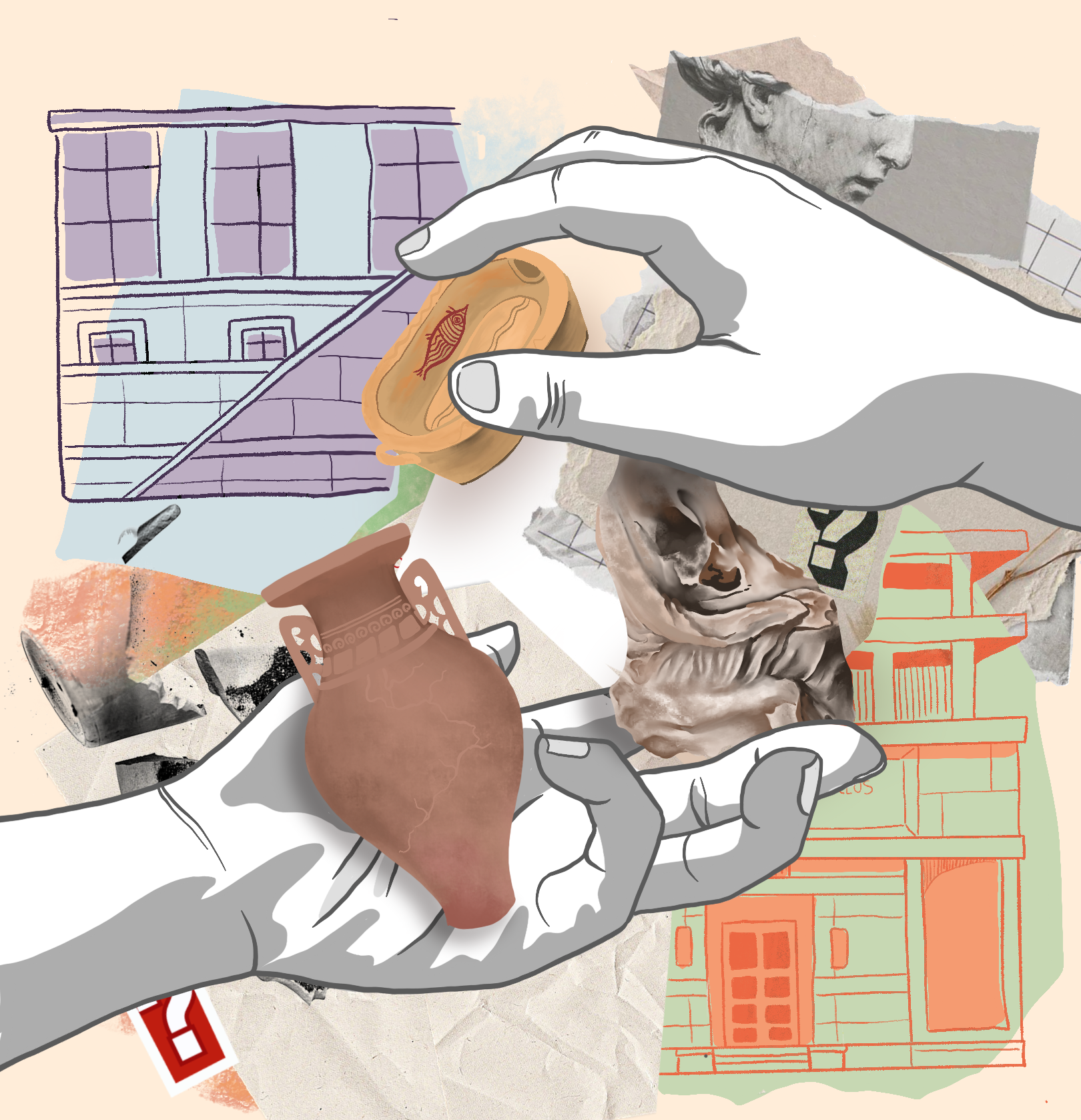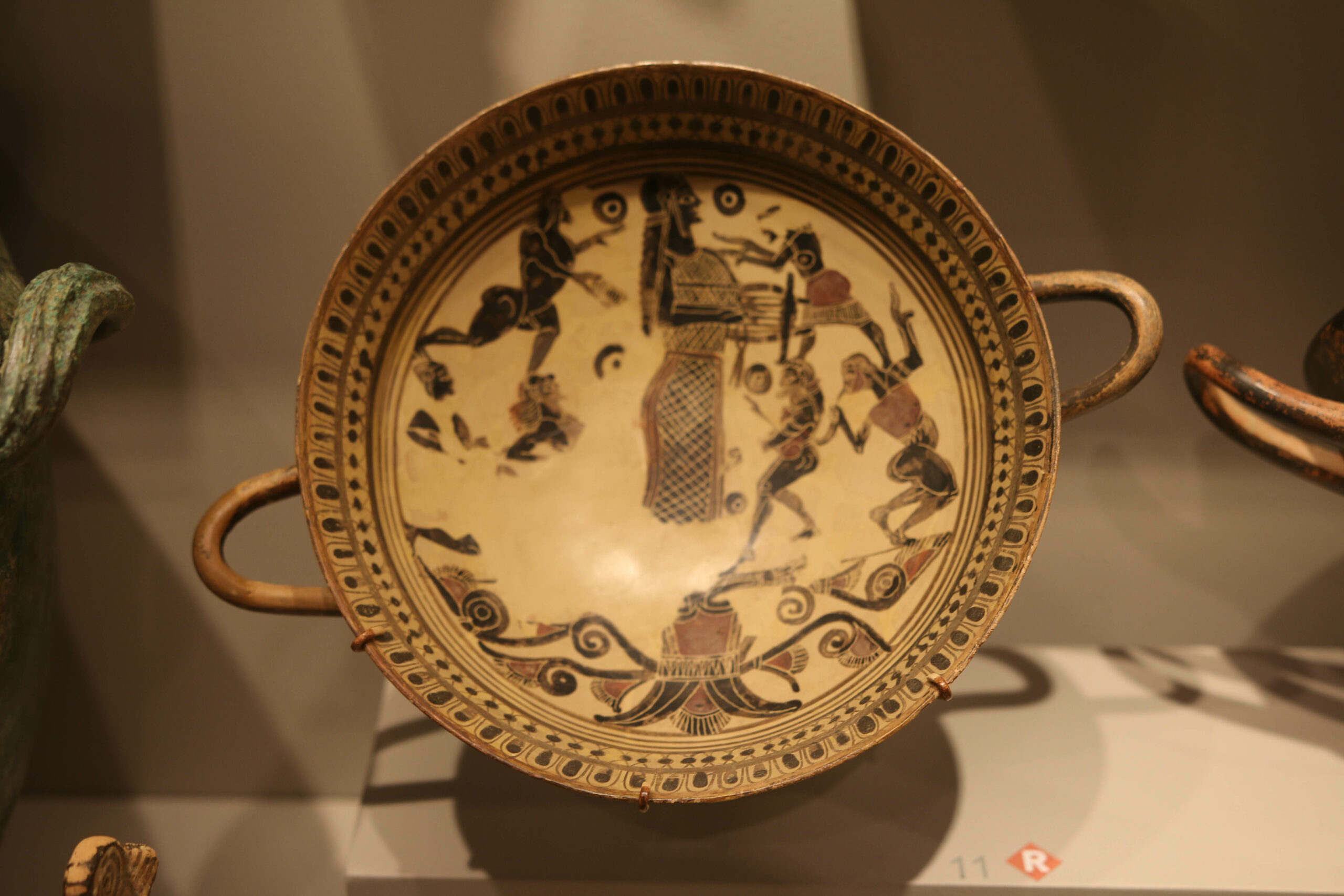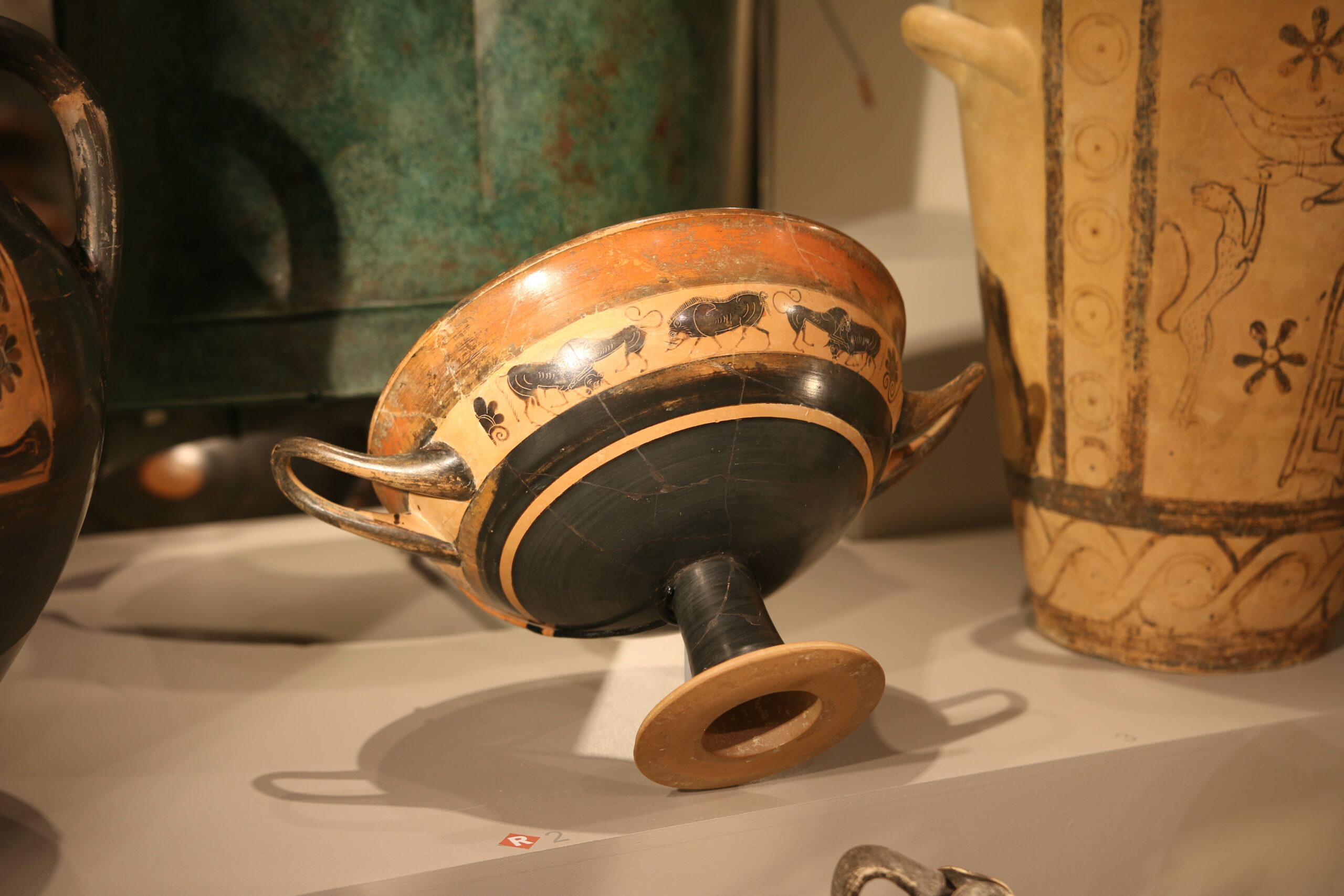Jack Rutherford/Staff Photographer
On any given day, Michael C. Carlos Museum visitors may walk through galleries filled with ancient artifacts: coffin boards from Egypt, effigy vessels from the Americas and marble statues from Greece and Rome.
One such visitor was Anusha Panjwani (24C), a human health major and Middle Eastern and South Asian Studies (MESAS) minor, who visited the Carlos Museum this semester with her MESAS 102 class. The class is entitled “Introduction to South Asian Civilizations” and taught by Associate Professor in Telugu Culture, Literature and History Harshita Mruthinti Kamath (04C, 12G).
On a class visit to the Carlos Museum’s Asian Art collection, Panjwani asked Kamath where the pieces in the collection came from. This proved difficult to conclude, as many of the objects were donated or the Carlos Museum purchased them from auction houses like Sotheby’s that do not always display the full history of the item.
In Kamath’s class after the museum visit, Panjwani led a discussion of an article in The Chronicle of Higher Education from August that detailed the Carlos Museum’s past acquisitions of objects in the Greek and Roman Art collection from dealers or collectors who are associated with the illegal antiquities trade. The article found that the museum had acquired objects with incomplete provenance, which troubled Panjwani.
Provenance is the history of an object’s ownership, according to the museum’s website. In the event that research into an object’s provenance indicates that the object may have been looted or imported into the United States illegally, “the Carlos takes immediate steps to rectify the situation and determine rightful ownership,” the museum’s website states. In some cases, the resolution is to restitute or repatriate the object which involves returning the piece to the country of origin, according to UNESCO.
“It’s definitely upsetting to hear that your university engages in that type of behavior because we have so many classes that talk about how problematic these things are,” Panjwani said.
Emory University is one of many universities whose museums have faced scrutiny in their acquisitions of objects connected to dealers associated with the illicit antiquities trade. The Manhattan District Attorney’s office has seized objects from Princeton University (N.J.) and Fordham University (N.Y.) under the suspicion that they may have been looted.
“[The University has] been so secretive about all of this,” Panjwani said. “I don’t think Emory students know that this is something happening at their own school.”
Years of Collecting
Emory’s museum has existed in some form or another since 1876. The University expanded the museum and renamed it to Michael C. Carlos Museum in 1993 after museum benefactor Michael C. Carlos made a $3.5 million donation. The Carlos family continued to contribute financially to the Carlos Museum, totalling $20 million in donations totalled over Michael C. Carlos’ lifetime, according to his obituary in Emory Magazine in 2003.
As the child of Greek immigrants, Carlos was passionate about increasing the museum’s Greek and Roman Art collection. The largest and most notable of his donations came in 1999, when Carlos donated $10 million specifically for the purpose of collecting Ancient Greek and Roman pieces.
In order to help manage the growing collection of Ancient Greek and Roman Art, the University named Greek and Roman art specialist Jasper Gaunt as the full-time curator of the collection in the fall 2001. Prior to his appointment, Gaunt worked at Christie’s auction house in London, a prominent art dealer and appraiser. He then moved to the United States where he studied with the former head of the department of Greek and Roman art at The Metropolitan Museum of Art, Dietrich von Bothmer. Gaunt also worked with notorious art dealer Robert Hecht before working at the Carlos Museum.
Part of what drew Gaunt to the Carlos Museum was its youth. It was an opportunity to build a collection of Ancient Greek and Roman Art, funded by the Carlos family’s donations, to rival some of the finest museums.
“The museum is in a position to seek out and go for the very best of what’s available,” Gaunt said in a spring 2002 piece in Emory Magazine. “We can bring in pieces which are just as good as anything anybody else has — anywhere. And building a collection seems to me to be something which is enormously creative. It’s very, very exciting.”
The Carlos Museum’s Greek and Roman Art collection currently contains over 6,500 pieces, according to the museum’s online catalog. The growing collection of Greek and Roman Art eventually included pieces like a Minoan bathtub, known as a larnax, from the 14th century BCE, over 300 Ancient Greek pottery fragments and a seated figure missing its head and limbs.
These objects are a few examples of the at least 562 objects that passed through owners or dealers that authorities have connected to the illegal antiquities trade, according to a survey conducted by The Chronicle of Higher Education.
The larnax was once in the possession of Ursula Becchina, wife of Gianfranco Becchina, a notorious illicit antiquities dealer. The pottery fragments are from von Bothmer, whose collection of over 15,000 pieces of pottery fragments has likewise come under scrutiny of looting, according to illicit antiquities investigative reporter Jason Felch. Other institutions have returned their share of these fragments to Italy. Gianfranco Becchina owned the seated figure at one point, and the Carlos Museum bought it from the Michael Ward Gallery. Ward has been suspected of dealing in looted art at various points since 1993 and was recently charged with facilitating the trafficking of illicit antiquities.

Ivana Chen/Staff Illustrator
Provenance research
Gaunt left the Carlos Museum with no press release in 2018, after which Emory hired Ruth Allen as the new curator of Greek and Roman Art in 2019. In the summer of 2022, Emory hired Henry Kim as the new associate vice provost and director of the Carlos Museum following former Carlos Museum Director Bonnie Speed’s retirement in 2021.
“Museums can be teachers as well as advocates, but most importantly they need to be exemplars, embracing the present, the personal and the uncomfortable,” Kim said in an Emory press release.
According to the Carlos Museum’s Statement of Acquisitions, the museum follows the Association of Art Museum Directors’ guidelines on the acquisitions of new objects and best practices regarding researching the provenance of an object.
The Carlos Museum has employed Annie Shanley as the provenance researcher since 2020 in the collections management department of the Carlos Museum. Collection curators, faculty, students and scholars from other institutions also help with provenance research, according to a statement Kim wrote to The Emory Wheel.
The research of scholars is crucial to provenance work at a museum. Sometimes researchers can properly understand an object’’s provenance through published scholarship on that object, according to Emory Visiting Assistant Professor of Art History Andrew Farinholt Ward.
Ward gave the example of a relief pithos in the Carlos Museum’s collection that the museum purchased from the Phoenix Ancient Art Museum in 2003. The museum has dealt in looted antiquities, raising questions about the piece, Ward said.
It is hard to know who to repatriate an object like the pithos to without proper research into where the object came from geographically, Ward said.
“The Carlos is aware that these pieces might have a questionable provenance, but we can’t just give it back because there needs to be someone who is claiming the piece,” Ward said.
However, a lack of complete provenance is not a reason to refrain from displaying an object, according to Kim. In the case that the piece is missing provenance, the Carlos Museum relies on visual cues on the object to signify where it can be attributed to culturally.
“One vital element in provenance research is developing an understanding of the people who were involved in the history of an object,” Kim wrote. “Where a person is known to have been involved in illicit activities, this raises a red flag for our researchers, warranting further inquiry into an object’s history. When facts emerge that challenge a purported history, we publish the information online and where warranted we work with the relevant parties to determine a path forward.”
Ward said that in an ideal world, museums would have a central international register where items could be listed with their complete history. Unfortunately, such a register does not exist.
“Institutions are opening their doors; auction houses are more willing to share collecting histories,” Ward said. “Generally folks are more willing to share in this dialogue whereas 10 years ago, people would be worried that if they did so they would make themselves liable. They didn’t want to open themselves up for lawsuits.”

Jack Rutherford/Staff Photographer
Recent repatriations
Gaunt left the Carlos Museum with no press release in 2018, after which Emory hired Ruth Allen as the new curator of Greek and Roman Art in 2019. In the summer of 2022, Emory hired Henry Kim as the new associate vice provost and director of the Carlos Museum following former Carlos Museum Director Bonnie Speed’s retirement in 2021.
“Museums can be teachers as well as advocates, but most importantly they need to be exemplars, embracing the present, the personal and the uncomfortable,” Kim said in an Emory press release.
According to the Carlos Museum’s Statement of Acquisitions, the museum follows the Association of Art Museum Directors’ guidelines on the acquisitions of new objects and best practices regarding researching the provenance of an object.
The Carlos Museum has employed Annie Shanley as the provenance researcher since 2020 in the collections management department of the Carlos Museum. Collection curators, faculty, students and scholars from other institutions also help with provenance research, according to a statement Kim wrote to The Emory Wheel.
The research of scholars is crucial to provenance work at a museum. Sometimes researchers can properly understand an object’’s provenance through published scholarship on that object, according to Emory Visiting Assistant Professor of Art History Andrew Farinholt Ward.
Ward gave the example of a relief pithos in the Carlos Museum’s collection that the museum purchased from Phoenix Ancient Art gallery in 2003. The gallery has dealt in looted antiquities, raising questions about the piece, Ward said.
It is hard to know who to repatriate an object like the pithos to without proper research into where the object came from geographically, Ward said.
“The Carlos is aware that these pieces might have a questionable provenance, but we can’t just give it back because there needs to be someone who is claiming the piece,” Ward said.
However, a lack of complete provenance is not a reason to refrain from displaying an object, according to Kim. In the case that the piece is missing provenance, the Carlos Museum relies on visual cues on the object to signify where it can be attributed to culturally.
“One vital element in provenance research is developing an understanding of the people who were involved in the history of an object,” Kim wrote. “Where a person is known to have been involved in illicit activities, this raises a red flag for our researchers, warranting further inquiry into an object’s history. When facts emerge that challenge a purported history, we publish the information online and where warranted we work with the relevant parties to determine a path forward.”
Ward said that in an ideal world, museums would have a central international register where items could be listed with their complete history. Unfortunately, such a register does not exist.
“Institutions are opening their doors; auction houses are more willing to share collecting histories,” Ward said. “Generally folks are more willing to share in this dialogue whereas 10 years ago, people would be worried that if they did so they would make themselves liable. They didn’t want to open themselves up for lawsuits.”

Jack Rutherford/Staff Photographer
A Path Forward
University museums are in many ways perfectly set up to address issues of questionable acquisitions and provenance, Marlowe said.
“A thing [a university museum] addresses can be the changing ethics around museum acquisitions,” Marlowe said. “You can imagine that as a course title: ‘Cultural Property Over the Last 50 Years.’ How has our understanding of this concept grown, emerged, changed, been challenged?”
Ward and Allen are co-teaching an art history seminar in the spring of 2024 about Greek vase painting at the Carlos Museum. The class is centered around the pottery shards in the museum’s Permanent Collections, many of which were donated by von Bothmer, according to Ward.
“The work of the class is building on that provenance research,” Ward said. “The idea being that we are trying to do the work, trying to do the research … cognizant of [that] we don’t want to be taking advantage of a situation in using objects that have been looted, but trying to reconstruct that history.”
Emory has offered courses on looting and museum ethics like “Interdisciplinary Seminar: The Ethics of Museums & Ownership,” a graduate seminar co-taught by six Emory faculty in spring 2022 and “Whose Antiquity? Looting and the Evolution of Cultural Heritage” taught by Ward in spring 2023. However, as of right now, Emory does not offer a museum studies program or any in depth courses about the history of collecting at the Carlos Museum, unlike Colgate University, which offers an interdisciplinary
minor in museum studies. Emory’s Art History department does offer a museums concentration within the Art History major which requires students to take several Art History courses with a museum focus.
A university should be able to criticize itself, and academics should be able to criticize universities without being concerned with the optics, Marlowe explained.
“University museums have the freedom to tell these messy stories, and they should embrace that,” Marlowe said.
Correction (12/4/2023 at 8:02 p.m.): A previous version of this article incorrectly described Phoenix Ancient Art as a museum. The article has been updated to clarify that the Phoenix Ancient Art is an ancient art gallery and dealer, not a museum. In addition, an earlier version of this article stated that Emory does not offer a museum studies program. This article has been updated to include the information that Emory offers a museum concentration within the Art History major.

